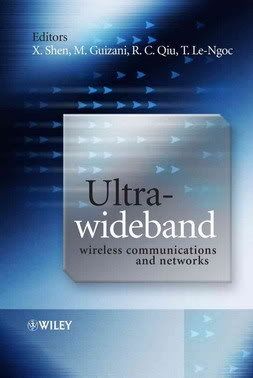
Author(s) : Xuemin Shen, Mohsen Guizani, Robert Caiming Qiu, Tho Le-Ngoc
Publisher : Wiley
Year : Feb 2006
ISBN 10 : 0470011440
ISBN 13 : 9780470011447
Language : English
Pages : 322
File type : PDF
Size : 2.8 MB
A UWB system is defined as any radio system that has a 10-dB bandwidth larger than 20 % of its center frequency, or has a 10-dB bandwidth equal to or larger than 500 MHz. The recent approval of UWB technology by Federal Communications Commission (FCC) of the United States reserves the unlicensed frequency band between 3.1 and 10.6 GHz (7.5 GHz) for indoor UWB wireless communication systems. It is expected that many conventional principles and approaches used for short-range wireless communications will be reevaluated and a new industrial sector in short-range (e.g., 10 m) wireless communications with high data rate (e.g., 400 Mbps) will be formed. Further, industrial standards IEEE 802.15.3a (high data rate) and IEEE 802.15.4a (very low data rate) based on UWB technology have been introduced.
UWB technology has many benefits owing to its ultra-wideband nature, which include high data rate, less path loss and better immunity to multipath propagation, availability of low-cost transceivers, low transmit power and low interference, and so on. On the other hand, there exist many technical challenges in UWB deployment, such as the received-waveform distortion from each distinct delayed propagation path, antenna design for and synchronization of very short pulses, performance degradation due to multiple access interference and narrowband jamming, employment of higher order modulation schemes to improve capacity or throughput, and development of link and network layers to take advantage of the UWB transmission benefits at the physical layer.
Even though R&D results so far have demonstrated that UWB radio is a promising solution for high-rate short-range wireless communications, further extensive investigation, experiments, and development are necessary for developing effective and efficient UWB communication systems and UWB technology. This book is timely in reporting the results from cutting edge research and state-of-the-art technology in UWB wireless communications.
TABLE OF CONTENT:
Chapter 01 - Introduction
Chapter 02 - Modulation and Signal Detection in UWB
Chapter 03 - UWB Pulse Propagation and Detection
Chapter 04 - Timing Synchronization for UWB Impulse Radios
Chapter 05 - Error Performance of Pulsed Ultra-wideband Systems in Indoor Environments
Chapter 06 - Mixed-Signal Ultra-wideband Communications Receivers
Chapter 07 - Trends in Ultra-wideband Transceiver Design
Chapter 08 - UWB MAC and Ad Hoc Networks
Chapter 09 - Radio Resource Management for Ultra-wideband Communications
Chapter 10 - Pulsed UWB Interference to Narrowband Receivers
Chapter 11 - Digital-Carrier Spreading Codes for Baseband UWB Multiaccess
Chapter 12 - Localization
Link1
Link2
Link3
password:ganelon
Publisher : Wiley
Year : Feb 2006
ISBN 10 : 0470011440
ISBN 13 : 9780470011447
Language : English
Pages : 322
File type : PDF
Size : 2.8 MB
A UWB system is defined as any radio system that has a 10-dB bandwidth larger than 20 % of its center frequency, or has a 10-dB bandwidth equal to or larger than 500 MHz. The recent approval of UWB technology by Federal Communications Commission (FCC) of the United States reserves the unlicensed frequency band between 3.1 and 10.6 GHz (7.5 GHz) for indoor UWB wireless communication systems. It is expected that many conventional principles and approaches used for short-range wireless communications will be reevaluated and a new industrial sector in short-range (e.g., 10 m) wireless communications with high data rate (e.g., 400 Mbps) will be formed. Further, industrial standards IEEE 802.15.3a (high data rate) and IEEE 802.15.4a (very low data rate) based on UWB technology have been introduced.
UWB technology has many benefits owing to its ultra-wideband nature, which include high data rate, less path loss and better immunity to multipath propagation, availability of low-cost transceivers, low transmit power and low interference, and so on. On the other hand, there exist many technical challenges in UWB deployment, such as the received-waveform distortion from each distinct delayed propagation path, antenna design for and synchronization of very short pulses, performance degradation due to multiple access interference and narrowband jamming, employment of higher order modulation schemes to improve capacity or throughput, and development of link and network layers to take advantage of the UWB transmission benefits at the physical layer.
Even though R&D results so far have demonstrated that UWB radio is a promising solution for high-rate short-range wireless communications, further extensive investigation, experiments, and development are necessary for developing effective and efficient UWB communication systems and UWB technology. This book is timely in reporting the results from cutting edge research and state-of-the-art technology in UWB wireless communications.
TABLE OF CONTENT:
Chapter 01 - Introduction
Chapter 02 - Modulation and Signal Detection in UWB
Chapter 03 - UWB Pulse Propagation and Detection
Chapter 04 - Timing Synchronization for UWB Impulse Radios
Chapter 05 - Error Performance of Pulsed Ultra-wideband Systems in Indoor Environments
Chapter 06 - Mixed-Signal Ultra-wideband Communications Receivers
Chapter 07 - Trends in Ultra-wideband Transceiver Design
Chapter 08 - UWB MAC and Ad Hoc Networks
Chapter 09 - Radio Resource Management for Ultra-wideband Communications
Chapter 10 - Pulsed UWB Interference to Narrowband Receivers
Chapter 11 - Digital-Carrier Spreading Codes for Baseband UWB Multiaccess
Chapter 12 - Localization
Link1
Link2
Link3
password:ganelon







0 Responses to "Ultra Wideband Wireless Communications And Networks"
Post a Comment